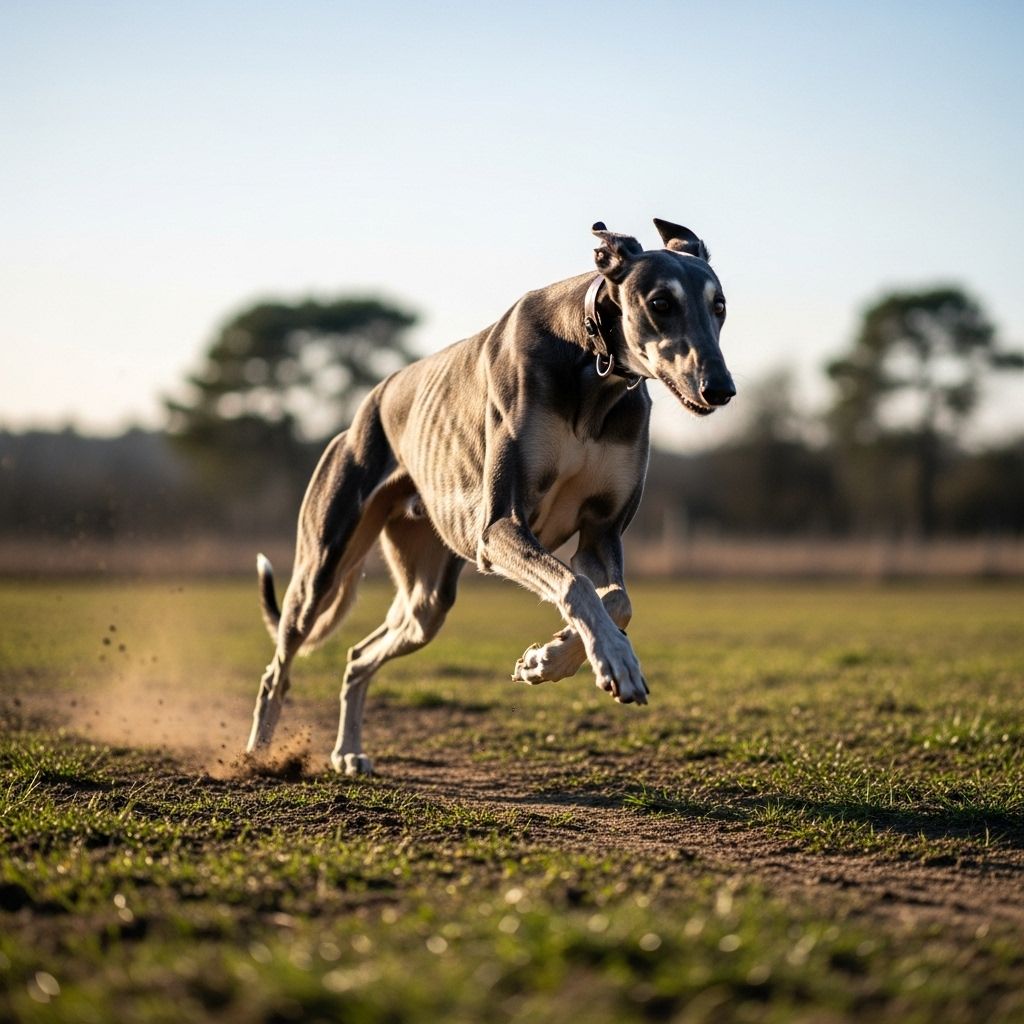How Fast Can A Dog Run? 10 Breeds Hitting Top Speeds
Insights into canine athleticism and how health and drive influence sprinting ability.

How Fast Can a Dog Run? Speeds, Breeds, and Canine Athletes
If you’ve ever seen your dog sprinting across the park, you’ve probably wondered: how fast can a dog run? From record-breaking Greyhounds to energetic Jack Russell Terriers, dogs are built for speed in ways that often surprise their owners. This article examines the science behind canine running speeds, highlights the fastest breeds, and helps you understand how your furry friend measures up—plus, we’ll answer common questions about running safely with dogs.
Average Dog Running Speed
The average dog can run at speeds between 15 and 20 miles per hour (mph) (24 to 32 kilometers per hour) for short distances. This range includes a wide variety of breeds and body sizes, from tiny Chihuahuas to mid-sized retrievers. However, individual results will vary depending on breed, age, health, training, and motivation.*
- 15–20 mph is the typical top speed for most pet dogs in a sprint.
- Dogs are usually significantly faster than their human companions—the average man runs at roughly 8 mph, and the average woman at around 6 mph.
- The world’s fastest human, Usain Bolt, reached 27 mph during his 100-meter world record.2
Why Are Dogs So Fast?
Dogs are the product of thousands of years of evolution as hunters and herders, resulting in several physical adaptations that allow incredible bursts of speed:
- Flexible Spine: A dog’s spine stretches and contracts dramatically with every stride, similar to cheetahs, helping them cover maximum ground rapidly.3
- Long, Powerful Legs: Many fast breeds have long limbs relative to their body, providing a greater stride length and speed.
- No Collarbone: Dogs lack a fixed collarbone (clavicle), letting their shoulder blades move freely and increasing running range of motion.3
- Muscle Structure: Strong haunch muscles provide explosive power for acceleration.
- Paw Pads: Grippy, shock-absorbing paw pads give dogs the traction needed to sprint.1
Top 10 Fastest Dog Breeds
While any dog can achieve impressive speeds in play, some breeds are record-breaking runners, bred for chasing, herding, or coursing. Here’s a look at the fastest breeds and their typical top speeds:
| Breed | Top Speed (mph) | Primary Purpose |
|---|---|---|
| Greyhound | 45 | Racing, coursing game |
| Saluki | 42 | Desert hunting |
| Vizsla | 40 | Hunting, retrieving |
| Borzois | 36 | Wolf hunting, coursing |
| Dalmatian | 37 | Carriage guarding, endurance |
| Whippet | 35 | Racing, rabbit hunting |
| Border Collie | 30 | Sheep herding |
| German Shepherd | 30 | Herding, police work |
| Boxer | 30 | Working, guarding |
| Jack Russell Terrier | 38 | Fox hunting, agility |
Note that there are slight variations reported between sources and among individuals of the same breed.1,4
Spotlight on the Greyhound: World’s Fastest Dog
The Greyhound is universally recognized as the fastest dog breed, capable of reaching up to 45 miles per hour in short sprints. Their aerodynamic bodies, deep chests, flexible backs, and elongated limbs have made them the ultimate canine racers, both in sports and throughout history.1,2,3,4
Other Notably Speedy Breeds
- Whippet: Similar to Greyhounds but smaller, Whippets can hit 35 mph and excel at short-distance sprinting.
- Dalmatian: Historically bred to run alongside carriages, they are known for their high speeds (up to 37 mph) and outstanding stamina.3,4
- Jack Russell Terrier: Small but mighty, reaching as high as 38 mph; originally bred for fox hunting.4
- Borzoi: Russian wolfhounds built for swift chases, maxing out at 36 mph.4
- Border Collie: Not just fast (up to 30 mph) but agile, making them champions in dog sports.
- German Shepherd and Boxer: These versatile working breeds commonly reach 30 mph.
Slower Dog Breeds: Built for Power, Not Speed
Not all dogs are sprinters—some are built more for strength, endurance, or just lounging. Breeds with short legs, heavier frames, or specialized airways tend to be much slower:
- Basset Hounds: Topping out at 5–10 mph, they are bred to track scents, not chase prey.1,2
- Bulldogs and Pugs: Their brachycephalic (short-nosed) faces can make high-speed running difficult or unsafe.
- Newfoundland: Powerful swimmers but much slower on land due to heavy builds.
- Shih Tzu: Often cited as the slowest breed, with speeds as low as 6 mph.3
What Factors Affect a Dog’s Running Speed?
Every dog is unique, and several factors will determine how fast yours can run:
- Breed Genetics: Built-in anatomy plays the greatest role—sighthounds, herders, and sporting breeds are often fastest.
- Age: Puppies and senior dogs are slower and tire more easily than young adults.
- Size and Body Shape: Longer legs generally mean a longer stride and higher top speed.
- Health & Weight: Overweight or unfit dogs may run slower and are at higher risk of injury. Joint and respiratory health are key.
- Motivation: Dogs often run fastest when chasing, playing, or following their favorite person.
- Training & Conditioning: As with people, dogs get faster and gain more stamina with practice and proper exercise routines.
Can You Run With Your Dog?
Many dogs make excellent jogging or trail running partners—but whether or not your dog is suited depends on several factors:
- Breed and Anatomy: High-energy breeds (e.g., Border Collies, Vizslas, German Shorthaired Pointers) excel at distance running. Short-nosed or heavy-set breeds may struggle.
- Age: Never run with puppies (under 12–18 months), whose bones are still developing, or with elderly dogs unless cleared by your vet.
- Health Clearance: Consult your veterinarian before starting a running program, especially for breeds prone to hip, elbow, or heart issues.
- Surface: Softer eco-friendly trails are preferable to pavement for joint health.
- Pacing: Remember, even the fastest breeds tend to sprint rather than run long distances—pace your dog and take breaks as needed.
- Hydration: Always bring water for both yourself and your dog.
Signs Your Dog Is Enjoying (or Not Enjoying) Running
- Happy, forward-facing posture, wagging tail, and alert expression signal enjoyment.
- Lagging behind, heavy panting, limping, or reluctance signal need to slow down or stop.
Making Your Dog Faster and Healthier
If you want to safely increase your dog’s fitness or running speed, try these tips:
- Regular Exercise: Gradually increase daily activity, mixing walks, play, and short sprints.
- Proper Nutrition: Feed a balanced, appropriate diet to support energy needs and joint health.
- Training: Practice recall and running games in safe, enclosed spaces.
- Strength & Agility Work: Incorporate agility courses, strength exercises, and swimming.
- Monitor Health: Schedule regular veterinary checkups and address any emerging health issues early.
Comparing Dog Speed to Other Animals and Humans
| Animal | Top Speed (mph) |
|---|---|
| Greyhound (dog) | 45 |
| Cheetah | 75 |
| Horse (Quarter Horse) | 55 |
| Jack Russell Terrier (dog) | 38 |
| Usain Bolt (human) | 27 |
| Average person (man) | 8 |
Dogs are significantly faster than most humans, but are outpaced by the world’s fastest land animal, the cheetah.
Frequently Asked Questions (FAQs)
Q: What is the fastest dog breed in the world?
A: The Greyhound holds the record for fastest dog, regularly sprinting up to 45 mph in races.
Q: Is it safe to run with any dog?
A: Not all dogs are suited to running long distances or at high speed. Consider your dog’s breed, age, health, and consult a vet before starting a running regimen.
Q: How far can the average dog run?
A: Most healthy, fit breeds can jog two to five miles with practice, but sustained sprints last less than a minute. Stamina varies by breed, health, and conditioning.
Q: What factors can slow down my dog?
A: Age, excess weight, joint or respiratory issues, flat-faced anatomy, and lack of exercise can reduce speed and stamina. Always monitor for discomfort.
Q: Can small dogs run fast?
A: While most small breeds aren’t as fast as sighthounds, many—like the Jack Russell Terrier—are impressively quick over short distances.
Key Takeaways
- Most pet dogs run 15–20 mph; top sighthounds reach 45 mph.
- Breed, age, health, and motivation all affect canine speed.
- Some breeds are built for endurance or scent-tracking, not all-out sprints.
- Running safely with your dog requires understanding their individual limits and needs.
Whether your dog is a lightning-fast Greyhound or a leisurely Bulldog, celebrating their unique abilities and keeping them active ensures a healthier, happier life for you both.
References
Read full bio of Anjali Sayee












